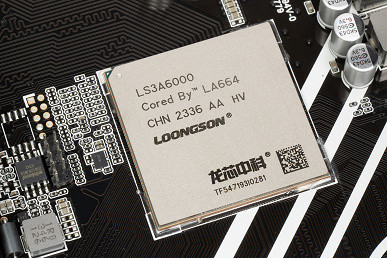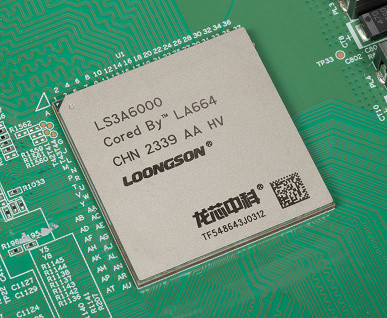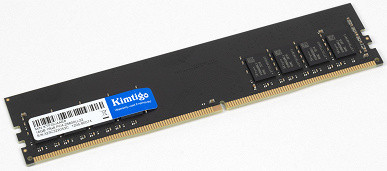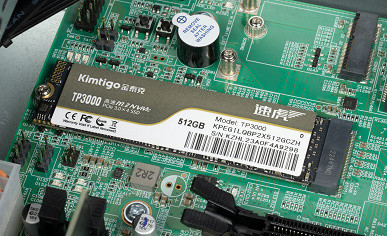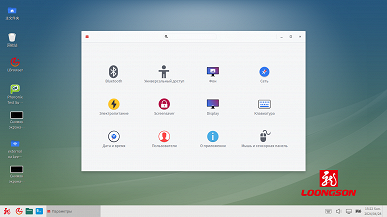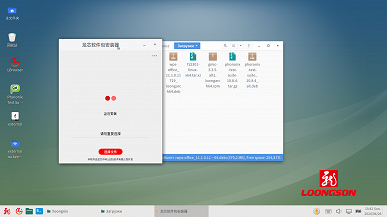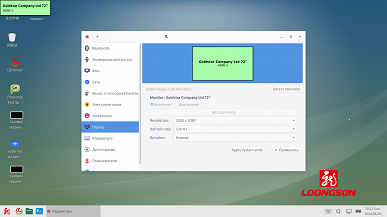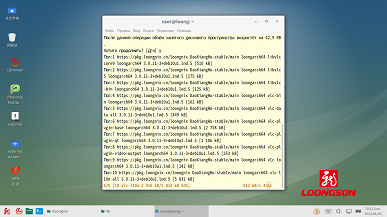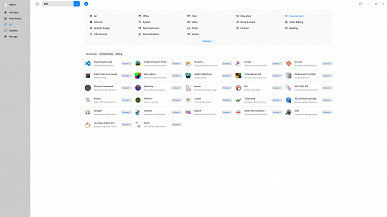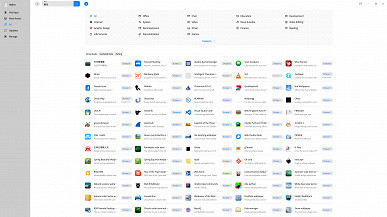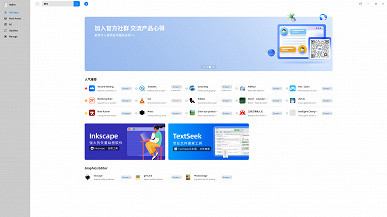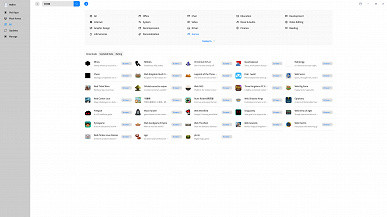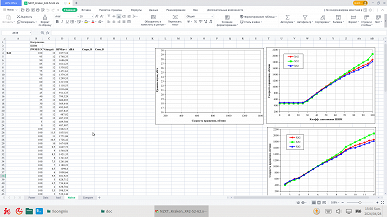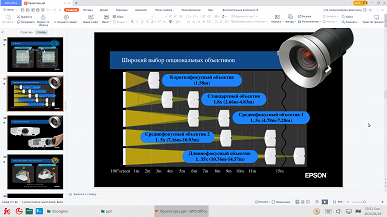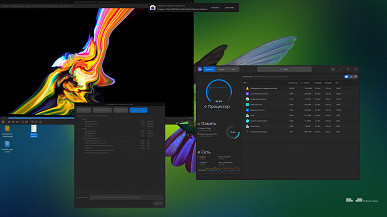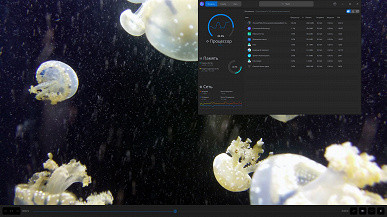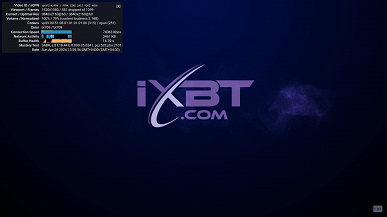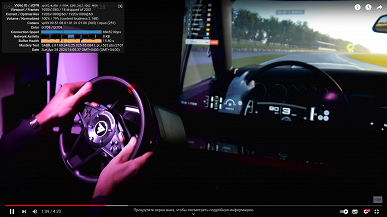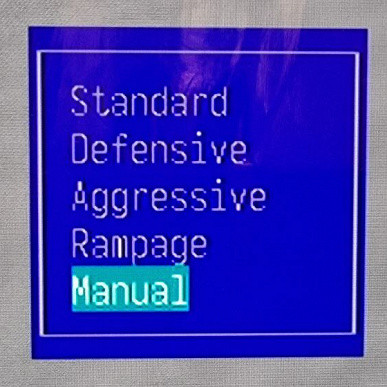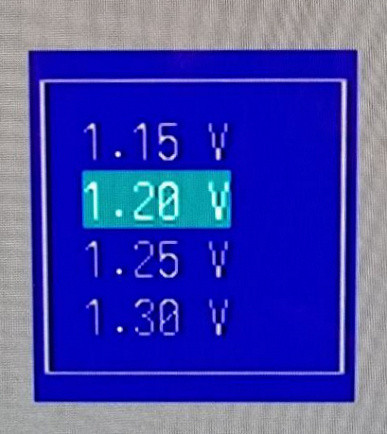We continue to study an unusual processor and systems based on it — the Chinese Loongson 3A6000, built on the company's proprietary architecture. In the first part of the article, we assessed the processor and PC performance in various benchmarks and came to the conclusion that in terms of the number of instructions executed per clock, the Chinese CPU has almost caught up with Western architectures of the past, such as Zen 1. However, it still lags noticeably behind modern solutions from AMD and Intel. The question arises: how comfortable is it to work on such systems, are there any hidden disadvantages that are not obvious at first glance?
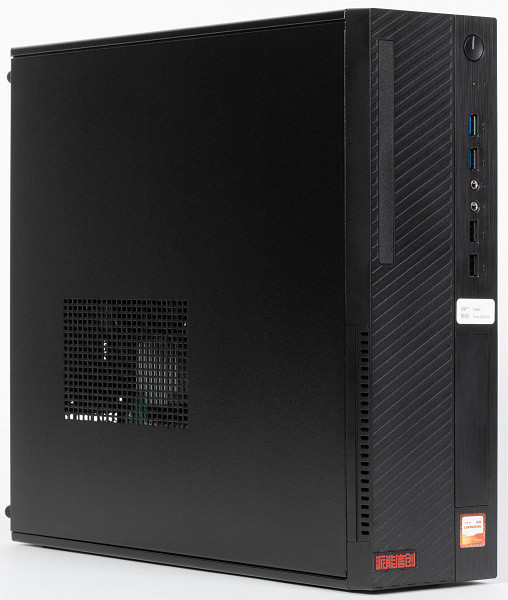
Western competitors have an advantage not only in clock frequency, number of cores and overall performance, but also in the widespread use of architecture, as well as a high level of optimization for the familiar x86 architecture. This is especially important in real tasks, because tests are often optimized first, and the software needed for work for rare architectures can be difficult to find — and this does not take into account the need for binary translation of x86 code. But in addition to the lack of necessary software and weak optimization, there are other features that can differ significantly from the usual systems based on AMD and Intel. In this article, we will discuss these points, as there is much to talk about.
Hardware
As mentioned, we had two different Loongson 3A6000-based systems: a pre-built Chinese PC with a full hardware set, and a standalone XC-LS3A6M motherboard with a processor and the included air cooler. These systems differ slightly in capabilities, although the processors in them are identical in modification, differing only in the production date. Both processors are soldered directly to the motherboards.
Let's start with the ready-made system from PNXC, shown in the photo at the beginning of the article. It is built on the PN-L530A motherboard, which uses the 7A2000 chipset and a soldered Loongson 3A6000 processor of the HV modification with a complete air cooler. The system also includes all the necessary components: a data drive and a RAM module. This kit is complemented by a relatively low-power, but sufficient power supply and a compact case, which is convenient and spacious, although perhaps even too large for such a simple configuration.
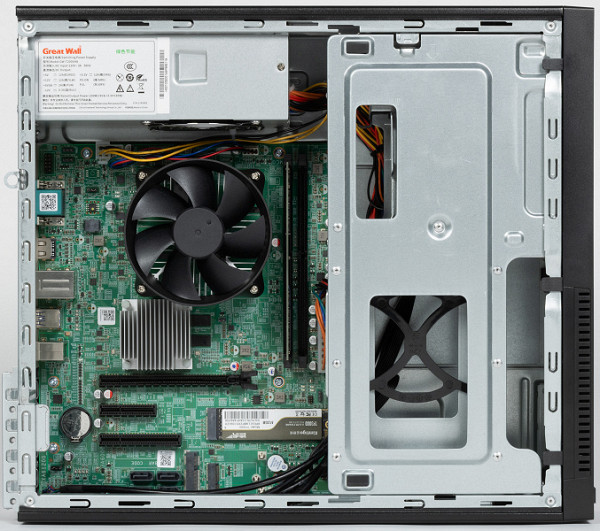
The system is equipped with a 512 GB Kimtigo TP3000 solid-state drive and one 16 GB DDR4-3200 RAM module from the same company with CL22 timings. The motherboard has two memory slots, and the Loongson 3A6000 controller supports dual-channel mode. Therefore, the optimal solution would be to install two modules, but this requires careful selection of compatible components that can stably operate at a frequency of DDR4-3200. In addition, the BIOS Setup does not have memory settings, which complicates setting up operation in dual-channel mode.
To cool one of the most powerful versions of the Chinese processor, designed for desktop PCs, a relatively simple cooling system by modern standards is used. It consists of a low aluminum radiator and a small fan. Such a cooler copes well with cooling the Loongson 3A6000, which in our tests did not exceed 60-65 degrees. The chipset also has a small aluminum radiator, but without a fan.
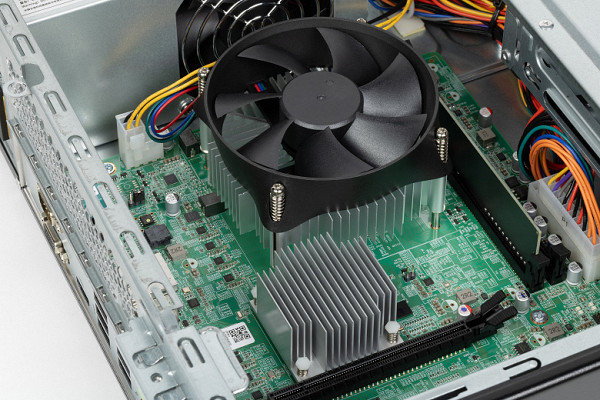
The rest of the system components are pretty standard for simple PCs: there are a sufficient number of connectors, such as PCIe x16, x8 and x4 slots, four SATA ports, M.2 2280 and 2230 slots, an Ethernet connector, HDMI and VGA video outputs, as well as several USB ports (3.0 and 2.0) on the front and rear panels. In addition, there are audio connectors. The only unusual thing for modern systems is the COM port, which is useful for specific tasks, for example, when developing software for various controllers.
The second system we tested is built on the XC-LS3A6M motherboard, which, according to rumors, was created by Asus, although its name is not officially mentioned anywhere. The board also has a soldered Loongson 3A6000 processor, which is logical, given the lack of upgrade options. The cooler is already pre-installed. This is what the board looks like without a cooling system.
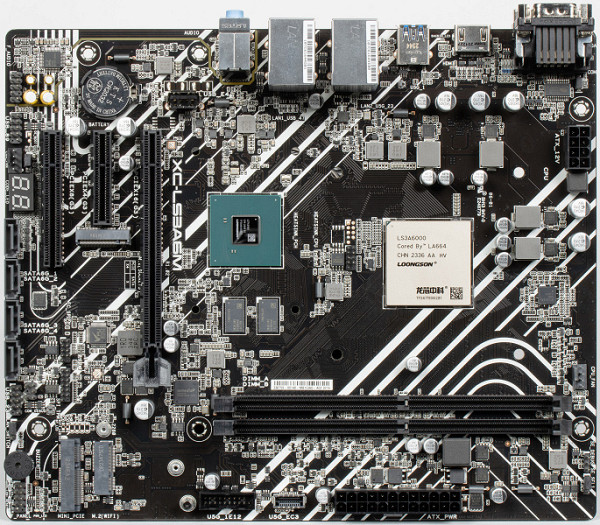
The CPU cooling system here is also quite simple, but a bit larger and probably a bit more efficient. However, this turned out to be unnecessary: even when overclocking the Loongson, the capabilities of this cooler were not fully utilized. The aluminum heatsink on the chipset is also noticeably larger. We will discuss this in more detail later in the section on overclocking capabilities of the processor.
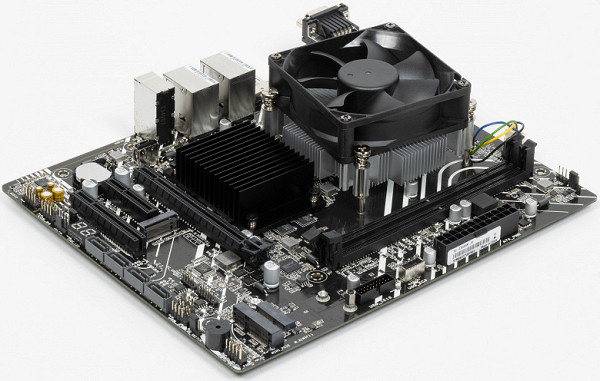
The XC-LS3A6M motherboard is made on black PCB and costs a little more than the unnamed green version, while offering slightly more expansion options. The number of memory, PCIe and M.2 slots is the same for both boards, but the XC-LS3A6M adds a second network adapter and a connector for an external USB 3.2 Type-C port. However, without documentation, it is difficult to understand the intricacies of the controllers and the distribution of PCIe lines, and there are simply no detailed technical documents from the manufacturer.
The board is also quite simple, but has diagnostic capabilities in the form of a speaker and a POST indicator, and the power supply is a little more powerful (which, however, is redundant for current Loongson models). The presence of two gigabit Ethernet controllers may be useful for using this system in a network infrastructure.
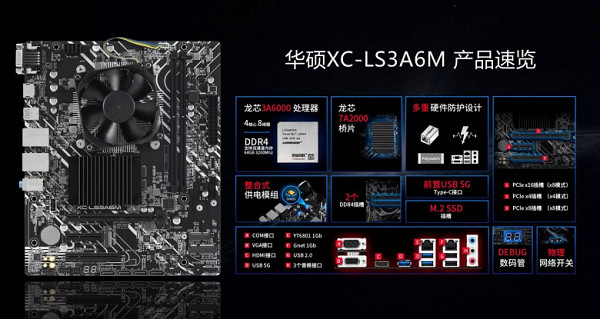
What is especially interesting for us is that this board has expanded BIOS Setup capabilities: overclocking and hardware monitoring settings are available. Although this is common for x86 architecture systems, such functions are not always found on rare processors. The BIOS declares the ability to overclock the processor, and according to Chinese researchers, when using air cooling, the CPU frequency can be increased to 2.6 GHz and higher, and with liquid nitrogen — up to 3 GHz. We will check this in practice a little later, but for now let's move on to the software part.
Operating systems
The conversation about the software side of the issue always starts with operating systems. You can't expect the usual versions of Windows, since Microsoft simply doesn't need them. Thus, only specialized versions of Linux remain. At the time of writing, there were only two full-fledged operating systems with official support for the LoongArch architecture: Loongnix and UOS. There are also test builds of the Russian Alt Linux, and over time, more supported systems will be available.
The ready-made PNXC system provided to us is equipped with a pre-installed UOS operating system based on Linux, and on the Asus board we used Loongnix, also based on Linux. Therefore, now we will briefly share our impressions of both systems, which differ mainly in appearance. However, the shells used are not visually that different from other modern operating systems.
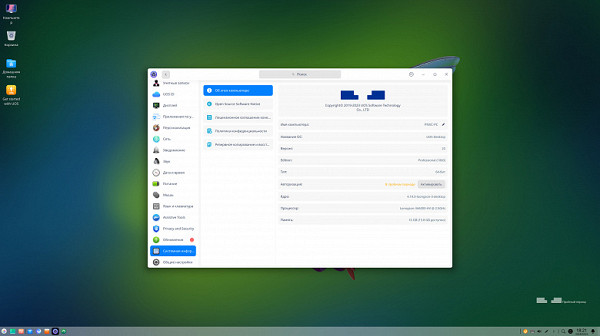
UOS (or Unity Operating System, or Unified Operating System) is an operating system based on the Deepin distribution, which is based on Debian. It was developed by UnionTech by order of the Chinese government to replace foreign operating systems. There are versions for desktop and server systems, and the first releases appeared back in 2019. UOS is aimed at the Chinese market and is designed to replace Microsoft Windows, supporting hardware platforms Zhaoxin, Loongson, Sunway, as well as processors based on the ARM architecture.
In general, for those who have already worked with Linux, UOS will not bring anything particularly new. However, a certain inconvenience turned out to be that in order to obtain superuser rights (root), you need to register using a phone, email or WeChat messenger. However, the phone option did not work, since a Chinese number is required, and the confirmation code arrives to the email with such a delay that it expires. Thus, the only working option was registration through WeChat, which is widespread in China. Also, the lack of Russian translation for some of the software, including the app store, was a bit annoying, but we'll talk about that later.
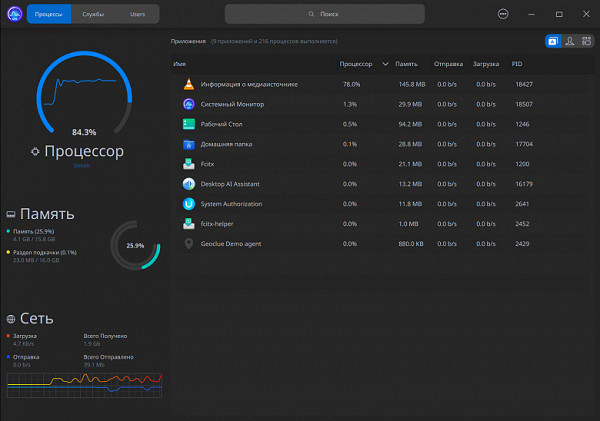
The UOS operating system includes all the necessary elements for basic operation, such as an Internet browser, a media player, and an app store, which we will talk about later. There is also a convenient system monitoring utility, useful for analyzing the use of system resources, which is especially important for less powerful PCs. Overall, UOS is a modern operating system with the basic functions necessary for an everyday user.
The second operating system, Loongnix, is also based on Linux and is supported by Loongson Technology Corporation. It is available in versions for PCs, servers, and embedded systems. The name of the system speaks for itself — it is designed exclusively for Loongson processors and does not support other architectures.
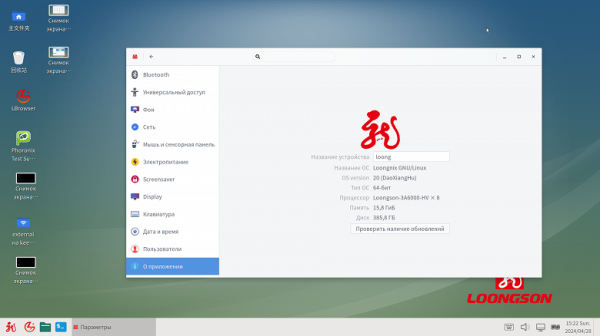
The Loongnix shell has a simpler, more austere aesthetic, with fewer visual elements. Otherwise, it is similar to UOS, as it is based on the same version of the Linux kernel, but has a different graphical shell and pre-installed software. The settings in Loongnix are also simplified, and the interface looks flatter and more classic.
We encountered a common problem: not all software elements are translated from Chinese. For example, while the trash can icon is tolerable, the package installer, which is entirely in Chinese, required us to use a translator to understand the interface. In general, both systems support English and even Russian at a fairly good level, but some parts of the translation are still missing.
Despite the similarity, more internal than visual, between the two systems, there is a noticeable difference in performance due to differences in the OS architecture and the level of optimization (UOS is a more universal system designed for various architectures, unlike Loongnix). In the first part of the article, we already presented a table with the results of testing using Stress-NG, a specialized tool for comprehensively assessing hardware performance.

According to the data obtained, the Loongson processor running the Loongnix operating system most often demonstrates better performance compared to UOS — in some tests the difference reaches 1.5 times, although such cases are rather an exception. In other benchmarks, Loongnix consistently shows an advantage of 2-4%, and sometimes even more.
For example, the Loongnix-based system provided 10% faster data compression in the 7zip and zstd formats, and for gzip the speed increased by 18%, and parallel bzip2 showed an increase of 23%. Note that we are talking specifically about compression — decompression was not accelerated. Performance gains were also noted in cryptographic tests (12-14% in aircrack-ng and bork) and high-performance computing (parboil and amg). In rare cases, UOS turned out to be faster, for example, in the rawtherapee and n-queens tests.
We cannot ignore the Russian development: for processors with the Loongarch64 architecture, the company «Basalt SPO» has prepared a preliminary assembly of the «Alt» operating system based on Linux with a graphical environment. This is the first Russian OS running on this platform, which can be installed on laptops, workstations and servers based on Loongson, and used with programs such as LibreOffice, Firefox and GIMP.
The porting was completed last year and continues to develop. The developers managed to adapt the OS in just nine months, receiving active support from the Chinese processor manufacturer, which provided documentation and test servers. At the time of writing, a build with the Xfce graphical interface, released in mid-June of this year, is available, and in the future, distributions for LoongArch64 are planned to be released. We have not yet conducted detailed testing of this OS, but its capabilities and features are already known to users. It is worth noting that this is still a preliminary assembly with some shortcomings.
Software
As mentioned, the UOS operating system includes its own app store, which is standard for modern operating systems. Users need a convenient environment for searching and installing software. The store is quite developed and offers many features, although its main drawback for foreign users is the lack of translation of much of the text from Chinese. However, most users can guess the meaning of the inscriptions or translate them using a mobile phone camera.
The UOS app store has sections by software category, rating lists, and automatic update options, as well as user reviews — everything you would expect from a modern app. However, the number of programs available is quite limited and cannot be compared with more popular systems. For example, at the time of writing, the store does not have a full-fledged office suite. It was not found either in the OS package or in the store, although we did find a version of WPS Office for LoongArch64 on a Chinese site.
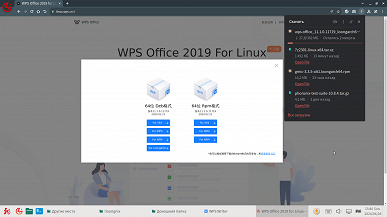
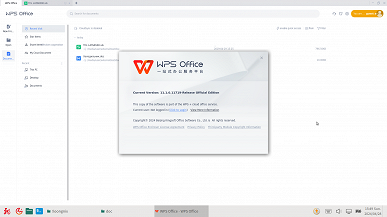
WPS Office, formerly known as Kingsoft Office, is an office suite developed by the Chinese company Kingsoft Corporation as an alternative to Microsoft Office. It is available for various operating systems, including Windows, Mac OS, Linux, Android, iOS, and HarmonyOS, and includes all the necessary tools: text and spreadsheet editors, as well as programs for creating presentations.
WPS has its pros and cons, and although it is not the best office suite, for such rare systems as LoongArch64, it is important that it is available at all and easy to download and install. However, it is worth noting that version 11.1, available for LoongArch64, is quite outdated (see screenshot), while version 12.2 has already been released for Windows. As a result, it may lack some modern features, but for basic work it is quite suitable.
As for the comfort of work, the output of information in the Full HD resolution (1920×1080, with support for a refresh rate of up to 120 Hz) is quite convenient, even on systems with weak integrated graphics processors. However, when switching to 4K (where the refresh rate is limited to 30 Hz), users accustomed to powerful x86 systems will encounter serious problems when updating information on the screen. This is due not only to the low refresh rate, but also to the insufficient power of the integrated GPU. It is also worth noting that the performance of the integrated graphics core strongly depends on the memory operating mode — single-channel or dual-channel. For example, in the GLmark2 test at a Full HD resolution, the integrated GPU scores 40 points in single-channel mode and 70 points in dual-channel, which is almost twice as much and significantly improves the working experience. Different operating systems also show different results: in Loongnix, the integrated GPU scored 110 points in dual-channel mode, and overall it is more convenient to work in this system, although UOS looks more attractive. The choice is up to the user.
Another option for improving graphics performance is to install a discrete graphics card, although only older AMD Radeon models are supported. Nvidia does not offer open-source drivers, which makes it impossible to compile them for other architectures. We tested the Radeon RX 480, and the results in GLmark2 reached almost 5000 points — which is significantly higher than the integrated GPU. In the GPU Drawing test of the HardInfo utility, the difference between the integrated graphics core and the Radeon was less noticeable: 2283 points in single-channel mode, 4108 in dual-channel mode, and 13152 points with the Radeon RX 480. However, the difference between the integrated graphics and even a weak discrete GPU can be noticed even in normal office work, so installing a discrete video card or using two memory modules for dual-channel mode would be a reasonable solution.
The browsers in both operating systems are based on the open source Chromium code and are quite similar, which makes them convenient for users. However, it is comfortable to work in them only with a limited number of open pages that are not overloaded with complex graphics and animations; otherwise, the system may become less responsive, and delays will be unacceptable.
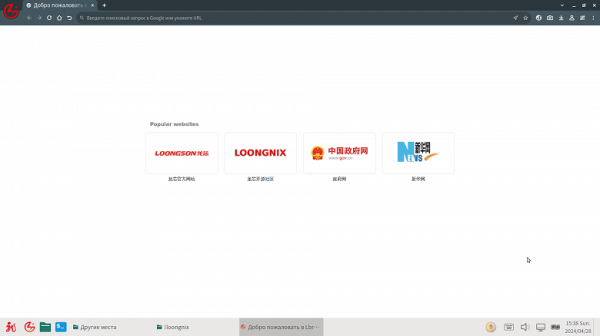
Overall, both systems are quite capable and can provide satisfactory comfort for undemanding users working with simple documents and not actively using background tasks — but only in Full HD resolution. It is important to note that such weak systems are not designed for higher resolutions, so this cannot be considered a serious drawback.
Watching videos
Another key task of any modern PC is viewing videos of various formats in high resolutions. At first glance, even outdated mobile chips cope with this quite well, since they are equipped with specialized units for hardware acceleration of video data decoding, which unloads other system components. However, the integrated GPU of Loongson does not provide hardware acceleration of video decoding.
In practice, we noticed differences between operating systems and media players, which may be related, for example, to the different degree of post-processing of video data. When examining the UOS system and the popular VLC media player, we found that this combination copes well only with old video formats such as MPEG2 and MPEG4, and only in Full HD resolution. When playing H.264, the CPU is loaded by 50-80%, and H.265 decoding does not work at all, which leads to frame loss. Almost any format in 4K resolution is not even played.
The built-in UOS media player is able to decode both 4K and H.265, but in full-screen mode it displays too few frames and misses most of them. Although it tries to play even 8K, it is very slow. If some acceleration is observed, then the output to the screen in 4K resolution suffers greatly, especially in single-channel memory mode. However, when switching to Full HD and using dual-channel memory, the player plays even 4K videos quite well, although CPU load can reach 60-70% depending on the video format. HEVC decoding in HDR is also not very stable.
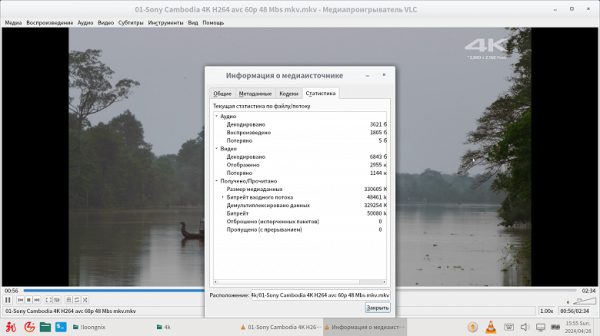
It is clear that you can try experimenting with different software and codecs, but we did not have such a deep goal this time. Interestingly, the situation turned out to be almost the opposite in the Loongnix operating system: the built-in media player works quite slowly and drops frames even in Full HD, while VLC shows more satisfactory results, although not much better than the built-in player in UOS. However, frame losses remain significant — see the playback statistics in the illustration. The main problem is insufficient support for decoding from the GPU. In a system with a discrete Radeon RX 480 graphics card installed, the situation improves significantly: almost all videos are played without problems, with the exception of 4K HDR HEVC and 8K.
Given the limitations of the integrated GPU, it is not surprising that streaming video playback is not the best. We conducted tests back in the era of fast YouTube, and while decoding and outputting Full HD video at 60 FPS is no problem (right screenshot), there are practically no problems with dropped frames. However, when trying to play 4K video at 60 FPS, the smoothness of the image deteriorates significantly — every second frame is dropped, and it is not possible to achieve comfortable playback. Thus, the conclusion from the «office» part of the review is confirmed again: the Loongson-based system copes well with Full HD resolution, but does not have enough power for higher resolutions.
Overclocking capabilities
We mentioned earlier that one of the motherboards we tested (XC-LS3A6M) offers some overclocking options, and its BIOS Setup does indeed have the appropriate settings. Unfortunately, we didn't have the hardware to capture images in this mode, and the usual software method for creating screenshots in BIOS didn't work. So below are some screenshots of the necessary items.
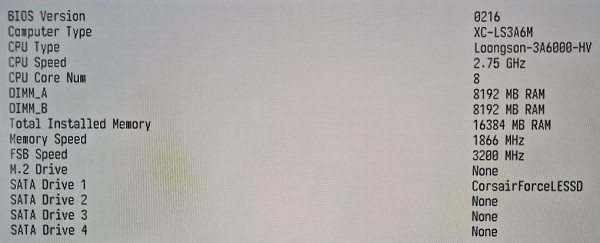
In the performance settings section (there is a typo in its English name), you can select an overclocking profile, change the number of clock frequency steps, select the CPU frequency itself, and adjust the processor voltage. In general, all the necessary parameters for overclocking the CPU are present, but it would be useful to also add the ability to select the frequency and adjust the memory timings.

Overclockers are offered four preset overclocking profiles, each with a different maximum frequency. However, in fact, the most useful is the manual profile, which allows the user to independently set values from the available options. The processor voltage can be adjusted in the range from 1.15 V to 1.30 V in 0.05 V increments.
Using the widest Fine-Tuning profile, the CPU frequency can be increased from the native 2.5 GHz to an impressive 3.2 GHz! However, the step between the values varies: closer to the maximum frequencies it is 25 MHz, while between 2.5 and 2.7 GHz it is only 100 MHz. Considering the significant overclocking potential of the Loongson 3A6000, smaller steps in the lower range would be very useful.

As for overclocking potential, some Chinese enthusiasts managed to overclock the Loongson 3A6000 to 2.63 GHz using air cooling on an XC-LS3A6M motherboard (possibly with a different BIOS version, since we did not have this value in the list of available ones), and to 3.0 GHz with liquid nitrogen. However, our attempts were less successful. The system started at 2.7 GHz, but the performance eventually caused software errors and freezes, indicating that the processor is unstable at this frequency.
Although the Loongson 3A6000 is probably capable of high frequencies with liquid nitrogen, with regular air cooling our sample is limited to 2.6 GHz, which is not a significant overclocking potential. At 2.8 GHz the system did not start, at 2.75 GHz and 1.30 V there were too many errors (without overheating), and at 2.70 GHz (with 1.30 and 1.25 V) there were still errors, although in smaller quantities. At 2.60 GHz the system worked, providing only a 4% increase in performance. The problem is clearly not in cooling, since the CPU did not overheat. However, installing water cooling was impossible due to the elements located close to the processor socket on the board, although the cooler mounting locations coincide with modern Intel processors.
The results of successful tests showed that at 2.7 GHz (which corresponds to +8% to the native frequency), the Loongson 3A6000-based system worked 6%-8% faster in most tests, including all data compression tests and some synthetic tests such as coremark, core-latency and cachebench. This confirms that increasing the clock frequency has a positive effect on cache memory performance. If Chinese engineers manage to significantly increase the clock frequencies of their processors in the future, this will immediately affect performance.
Subtleties of practical use
Now we should discuss some aspects of practical use of Loongson-based systems that were not covered in the previous sections. In particular, this concerns x86 emulation via binary translation of x86 code in LoongArch64. Although Loongson processors have special features to speed up this process, things are not that simple. Unlike Apple, which successfully and quickly implemented x86 emulation mode for its devices thanks to its control over hardware and software, the situation is more complicated in the Windows and Linux ecosystems. Microsoft has not shown much interest in the Windows version for LoongArch, so users have to limit themselves to Linux.
Although x86 emulation itself is mainly a software task, certain hardware capabilities are required to improve performance. Loongson has special instructions to speed up translation (LBT, Loongson Binary Translation), but even with them, the Chinese processor will not be able to execute x86 code as efficiently as AMD and Intel processors do. Emulation always incurs translation overhead that varies depending on the load, so it is advisable to compile performance-critical applications to native LoongArch64 code.
Despite Loongson having 128-bit LSX and 256-bit LASX instructions, it is quite difficult to fully emulate the AVX2 instruction set, let alone AVX-512, as they do not fully correspond to x86 instructions. Translating AVX/AVX2 to LSX/LASX is not an easy task, although it is probably solvable with varying efficiency.
We tested LATX on a Loongnix system, and in short, it is suitable only for those programs that do not have a native version for LoongArch64. For example, the 7zip archiver in x86 emulation mode with LATX binary translation works almost twice as slow as its LoongArch64 version. You can try playing PC games with Wine (DXVK is required to support modern versions of DirectX), but in practice this results in such low frame rates that it is pointless.
Conclusions
In the first part of the article, we established that the Loongson 3A6000 is approximately equal to the first-generation Zen processors in terms of efficiency and the number of executed instructions per clock. This Chinese processor is comparable to the Ryzen 5 1500X, operating at a reduced frequency of 2.5 GHz. Loongson often compares its 3A6000 with the Intel Core i3-10100, but the latter operates at a higher clock frequency of 4.3 GHz, which makes the comparison not entirely correct. In addition, AMD and Intel have models with a larger number of cores and even higher frequencies. Therefore, the 3A6000, even being the flagship among the processors of this Chinese company, is unlikely to be able to compete with outdated AMD and Intel processors.
As for rare and unpopular software, it is either completely absent from the LoongArch version, or has no optimizations for this architecture. Not all programs can use the SIMD instruction sets of the Chinese processor, which is necessary to achieve high performance. As a result, native software may not work as fast as on AMD and Intel processors with similar theoretical characteristics. This means that some programs will have to be launched in binary translation mode of x86 code, which further reduces the performance of systems based on the Chinese CPU.
Although the Loongson 3A6000 is the most powerful Chinese-made desktop processor, users accustomed to modern processors from Intel and AMD may experience slow operation of systems based on this CPU. The problem lies not only in the computing cores, but also in the integrated video core, which has a low information output speed and probably does not support hardware video decoding. Therefore, we recommend using even a simple discrete video card, such as the Radeon RX 550.
As a result, systems based on the Loongson 3A6000 processor are suitable mainly for simple office tasks, where for some reason the use of Western processors is not allowed. A PC based on this processor will provide minimal comfort when working with simple documents and leisurely web surfing. For smoother video viewing, it is recommended to install a discrete video card or use dual-channel RAM with an integrated GPU, limiting the resolution to Full HD.
In practice, the performance and capabilities of a completely Chinese processor are suitable only for basic tasks, and even then with a number of limitations. Most Chinese users, switching to domestic processors, will find their performance sufficient for everyday tasks, such as working with a browser, email and office applications. However, Loongson engineers have a lot of work to do to reach the level of even not the most modern CPUs and GPUs. Nevertheless, we can expect that the gap with Western developments will be reduced. The main thing is to pay more attention to the software, which is much more important for the practical use of a Loongson-based PC than the processor itself.
In general, the platform of the Chinese company is quite viable and can be used in office and home conditions, but only on the condition that users do not make demands on specific software that may only be available in x86-compatible format. It is often necessary to change familiar programs, for example, to replace Microsoft Office with the less functional WPS Office, which has serious limitations for active users. The main problem of all less common architectures is the lack of necessary software or lack of optimization for them, so the development of appropriate development tools and the transfer of familiar programs to the Chinese architecture is a long process. Not all software manufacturers will be interested in releasing specialized versions for Loongson. However, if it is possible to eliminate the shortcomings in the form of a small amount of native software, systems based on Chinese CPUs will become more suitable for everyday use.

